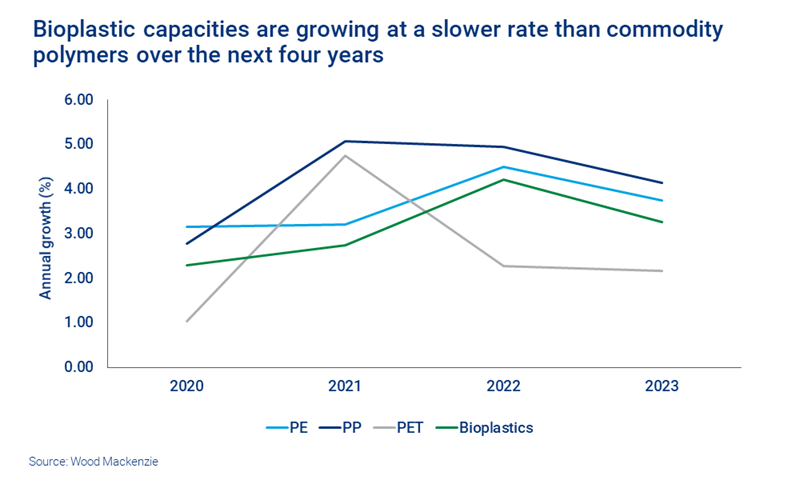Can bioplastics make the chemicals industry greener?
Biosourced, biodegradable polymers are a low-carbon alternative – but they’re yet to break into the mainstream
1 minute read
Guy Bailey
Head of Oils & Chemicals Markets

Guy Bailey
Head of Oils & Chemicals Markets
Guy brings over 15 years of experience in regulation and sustainability.
Latest articles by Guy
-
Opinion
Can legislation unlock a circular plastics economy?
-
Opinion
COP26: Can petrochemicals square the circle?
-
Opinion
Can chemical recycling make plastic more sustainable?
-
Opinion
Can bioplastics make the chemicals industry greener?
-
Opinion
What can the materials transition learn from the energy transition?
-
Case Study
Making materially better choices
Versatile and affordable, plastic was once the ultimate ‘wonder material’. Now its use is under fierce scrutiny and the plastics industry is searching for ways to cut its environmental footprint. From refiners to consumer-facing brands, the industry is putting both intellectual energy and investment into the search for sustainable solutions. Could biodegradable bioplastics be one such solution?
In the first of a new series of Chemical Solutions insights, we explore the potential for bioplastics to improve the sustainability of the chemicals value chain. Fill in the form for the insight brochure, which includes sample charts and a preview of the rest of the series. Or read on for three bioplastics FAQs.
What are the green credentials of bioplastics?
Public concern has risen sharply over the millions of tonnes of plastic waste produced each year. The plastics industry must keep pace with this shift in sentiment and take proactive steps to limit the environmental impact of our collective materials use. It’s not going to happen overnight – it calls for a materials transition, with the global ambition of the energy transition.
Bioplastics – such as polylactic acid (PLA), starch polymers or blends, polyhydroxyalkanoates (PHA) and polybutylene succinate (PBS) – are one possible piece of the materials transition puzzle. These polymers are biodegradable and come from biomass, not fossil fuels. As such, they’re a renewable resource with a substantially lower lifetime carbon footprint, and their use provides another route to cutting levels of plastic in the waste stream.
Read the full insight for more on the applications, manufacturing processes and market characteristic of each bioplastic in our study. Visit the store to purchase or fill in the form on this page for a preview.
What’s putting the brakes on a bigger role for bioplastics?
Despite the industry’s increased focus on sustainability, bioplastics currently make up less than 1% of global production. While we forecast healthy increases in capacity over the next few years, the growth rate is still behind expectations for commodity polymers such as polyethylene terephthalate (PET), polyethylene (PE) and polypropylene (PP). So, what’s holding bioplastics back?
There are several challenges. Individually, they’re not insurmountable, but together they have so far put the brakes on bioplastics achieving significant market share.
- Cost is a significant hurdle. Manufacturing bioplastics is often much more expensive than traditional polymers. Until bioplastics can consistently compete on price, they’re unlikely to displace commodity thermoplastics in most applications.
- There are wider sustainability costs to contend with. Manufacturers would have the challenge of limiting the agricultural impact of production, such as increased water use, reductions in biodiversity and fertiliser leaching into water systems.
- Given current scales, bioplastics are – arguably – a distraction. Building market share could mean diverting resources and efforts away from other sustainability measures, such as collecting and recycling plastic packaging.
Can bioplastics play a meaningful role in improving the sustainability of the chemicals industry?
Based on the fundamentals of their environmental footprint compared to that of virgin fossil fuel-derived plastics, the short answer is yes. At scale, bioplastics could significantly reduce the carbon emissions of the chemicals industry.
However, based on their current growth trajectories, bioplastics will find a market in niche applications – PLA in 3D printing and food service applications and starch polymers in disposable/compostable bags and liners, for instance. But they aren’t yet on a course to build the critical mass needed to challenge the commodity polymers.
Boosting bioplastics to the mainstream
Read the full insight for a look at the market characteristics of four types of bioplastic polymers – and our view on how bioplastics can cut costs, achieve scale and enter the global mainstream. Fill in the form at the top of this page for a preview.








